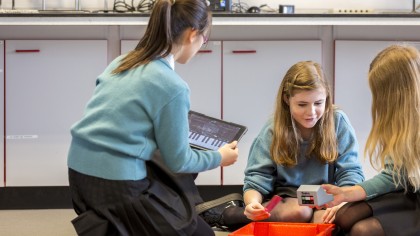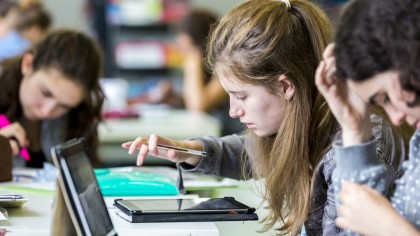An Apple for teacher: how tablets are changing education
Will a screen in every child's hand help them learn?
Should parents have to pay?
The key question that comes up time and again is one of cost: iPads are generally seen as a luxury device for consumers, so how can schools afford to equip students with devices? Should they not be looking at lower cost tablets?
Greg Hughes, assistant principal at the de Ferrers Academy, says the school preferred the iPad over other devices due to elements like the App Store, as well as its low failure rate.
"Cheaper devices seemed poorer in terms of performance, quality of camera and availability of apps," he said. "We love the fact that the iPad has such an easy learning curve. Students know how to use it almost instantaneously, so we haven't needed to give them any training all, just a few reminders about back-ups and so on.

"The students view Apple products as 'cool' and for many of our students from challenging backgrounds, having access to their own device is both aspirational and transformational, for them and their families."
The options to make Apple's tablets accessible are varied: from having a limited number of shared devices available for specific lessons, to the offer of school-funded iPads, schools are finding ways to get the devices into the hands of children.
According to the BESA study, the preferred method is for the school to pay for and own the devices, although there is appetite in secondary schools for parents to pay for the tablet, as they would for art supplies or school trips.
And anecdotally, parents seem to be happy paying for the devices where needed, as tablets and smartphones are already so commonplace that their use in education seems obvious – plus for any students on the Pupil Premium schemes (traditionally used for free school dinners and similar) it seems many schools are keen to use that money to help out with educational devices.
Sign up for breaking news, reviews, opinion, top tech deals, and more.
But the notion of a school funding the entire deployment of iPads may be more feasible than some might think, with Hughes from the de Ferrers academy calling the experiment "cost-neutral."
He pointed to a number of areas where costs have been saved through the deployment of iPads. These included: removing current virtual learning environments (saving about £10,000 a year), reductions in printing and photocopying (£20,000), cuts in computers and IT suite replacements (£45,000) and even moving to digital marking books, which would save thousands on its own.
The outlay is significant, as it costs £300 to equip the students with the tablets, a high total when over a thousand students are involved. However, de Ferrers asks for £1 per week per year for full use of the iPad (including being able to take it home) with an option to buy it outright at the end of the course. Given that 65% of students take up this option, the initial cost to the school is reduced by two thirds.
Are children safe online?
With any new tool, and especially one connected to the internet, there are understandable worries from parents about putting this technology into the hands of children. Who is watching them and making sure that they're not doing anything that can harm them?
Both schools I spoke to have robust systems in place to combat inappropriate use of the tablets, ensuring any device connected to the Wi-Fi network has restrictions on explicit or age-inappropriate content. Detailed device management also means the schools can see what apps are being installed on the tablets, allowing swift action to be taken.
Both schools also made sure that parents were educated on how the iPad was used in schools, giving them input into what their child is doing online, which Edwards said had proved successful in helping parents understand the role of the tablet.
"Often we get the child to get their smartphone out next to the parent so the child can access lots of things on the phone that the parent can't on the iPad thanks to our security," he added.

Parents are encouraged to set their own restrictions too: when at home in the family Wi-Fi environment, a separate passcode that only they know will enable them to set the child's privileges on the iPad.
Still work to do
There are other issues that need to be ironed out before the use of tablets in schools becomes more widespread – the most obvious one being the wireless connectivity required to enable it.
On average primary schools are only halfway towards an ideal level of broadband connectivity, according to BESA, although in the case of secondary schools, the situation is much better. It will require investment (both in the equipment and the security software), which adds to the cost of tablet deployment.
And besides budget, one of the most pressing issues preventing tablet adoption is the training and support teachers need to use tablets effectively in classrooms.
In the schools interviewed, this is primarily handled by one or two teachers engaged with the technology – however, for more widespread adoption there will need to be more readily available help. A number of schemes are being set up to help with this already, including iteach-UK, the iPad Academy and even Apple's own teacher training courses.
However, government research is needed to show that the tablet has a huge – and positive – effect on education, otherwise already overburdened teachers aren't going to take time out of their schedule to learn more about something that may not be of use.
Making a difference
What's been clear from looking at how the tablet is currently used in the classroom is that it's had a transformational effect. It's expanding how teachers are working with students, saving money and helping give pupils more freedom in their learning experience.
However, schools using iPads in the manner described above are still rare, with a lot of hurdles to overcome. Teachers need confidence (and training) in the technology, and board-wide agreement needs to happen over the implementation and funding to get the schemes off the ground.
Other tablet options from Microsoft and Google will also become prevalent in the future, meaning teachers will have more choice in terms of functionality and cost as tablets become the norm in schools – and anything that makes the transition easier is likely to accelerate the rate at which digital slates become a daily part of education.

Gareth has been part of the consumer technology world in a career spanning three decades. He started life as a staff writer on the fledgling TechRadar, and has grew with the site (primarily as phones, tablets and wearables editor) until becoming Global Editor in Chief in 2018. Gareth has written over 4,000 articles for TechRadar, has contributed expert insight to a number of other publications, chaired panels on zeitgeist technologies, presented at the Gadget Show Live as well as representing the brand on TV and radio for multiple channels including Sky, BBC, ITV and Al-Jazeera. Passionate about fitness, he can bore anyone rigid about stress management, sleep tracking, heart rate variance as well as bemoaning something about the latest iPhone, Galaxy or OLED TV.